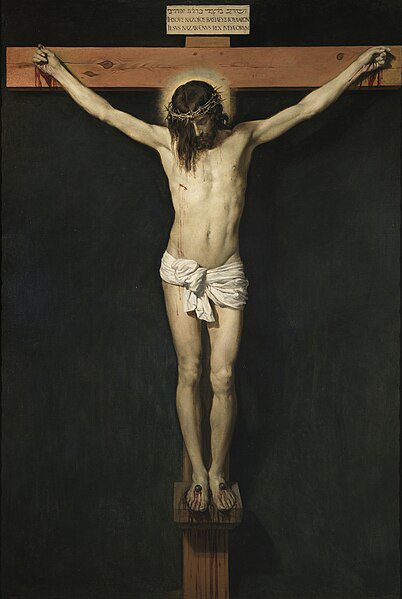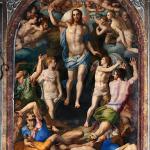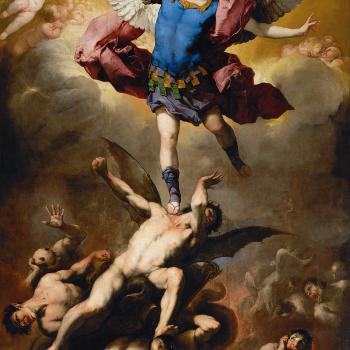Chapter 8 of my book (available for free online), Inspired!: 198 Supposed Biblical Contradictions Resolved. See the Introduction and ch. 1: How Do Atheists Define a “Biblical Contradiction”? All Bible passages RSV unless otherwise noted.
- Was money Judas’ motive for betraying Jesus (Matt. 26:14-15) or not (Mark 14:10-11)?
The claim here is that Mark doesn’t mention money as Judas’ motive. He proposed a betrayal to the “chief priests” and then they “promised to give him money.” But in Matthew’s account, the demand for money is seemingly mentioned by Judas upfront: “What will you give me if I deliver him to you?” Mark records that he “went to the chief priests in order to betray him to them” (Mark 14:10), but this doesn’t exclude a possibility that he said at the same time what Matthew records. Mark simply didn’t record that part. But that means it is only the usual weak “argument from silence” in the rush to find a biblical “contradiction” under every rock and to set Mark against Matthew in this regard. Whatever Judas said (and he must have said something), the chief priests were “glad, and promised to give him money” (Mark 14:11). Nothing in Mark’s text makes it impossible for filthy lucre to have been Judas’ motivation, and when Matthew makes this explicit, it merely complements Mark’s story (in a non-contradictory fashion). There are only so many reasons and motives for immoral people to do what they do. Usually they come down to very few (pride, envy, revenge, financial gain, etc.). That Judas’ motive was financial is not only indicated (most explicitly) by Matthew, but also by John’s report: “he was a thief, and as he had the money box he used to take what was put into it” (John 12:6).
- According to Matthew 26:15, the chief priests gave “thirty pieces of silver” to Judas. But how is that possible, since there were no silver coins used as currency in Jesus’ time, and there had not been any for about 300 years?
This is untrue. The shekel was made of silver, and was in use in Israel in the first century A.D. In the same book of Matthew, “the half-shekel tax” was referred to in 17:24. If atheists won’t accept that because it’s from the Bible (a most irrational attitude, given the Bible’s proven historical accuracy, again and again), then we can submit the Jewish first century historian Josephus, who referred to the half-shekel Temple tribute (Wars of the Jews, VII, ch. 6. Sec. 6). Moreover, at Horvat ‘Ethry in Israel (22 miles southwest of Jerusalem), between 1999 and 2001, Boaz Zissu and Amir Ganor of the Israeli Antiquities Authority discovered a half-Shekel coin from the 2nd century A.D., with the words “Half-Shekel” in paleo-Hebrew on it. It had a silver content of 6.87 grams. But there is more. Smithsonian Magazine, in an article dated September 16, 2022, noted that an ancient Jewish silver quarter-shekel, dated 69 A.D., had been found at an auction in Denver. So much for this atheist objection . . . I feel like I just crushed a grape with a sledgehammer.
- Matthew, Mark, and Luke state that Jesus was taken directly to the high priest (Matt. 26:57; Mark 14:53; Luke 22:54) after his arrest, but John reports that Jesus was taken to Annas, the father-in-law of the high priest (John 18:13) who, after an indeterminate period of time, sent Jesus to the high priest (John 18:24). And John mentions only the high priest questioning Jesus. How is all this harmonized?
John reports “So the band of soldiers and their captain and the officers of the Jews seized Jesus and bound him. First they led him to Annas; for he was the father-in-law of Caiaphas, who was high priest that year” (John 18:12-13), who “questioned Jesus about his disciples and his teaching ” (John 18:19). Note that this account specifically indicates sequence, by use of the word “first.” None of the Synoptic accounts have the word “first” or anything regarding sequence or chronology. Because of this use of “first” in John, there is no contradiction, and a synthesis is easily envisioned. John continues: “Annas then sent him bound to Caiaphas the high priest” (18:24). Then “they [implied: the Sanhedrin] led Jesus from the house of Caiaphas to the praetorium [where Pilate was]” (18:28). And “They answered him, “If this man were not an evildoer, we would not have handed him over” (18:30). Note that Caiaphas was present at the judgment and “monkey trial” of the Sanhedrin, as indicated by Matthew 26:57, 62, Mark (not named, but mentioned as the “high priest”: 14:53-54, 60, 63, 66), and Luke (“high priest”: 22:54). Therefore, it’s seen that it’s all the same overall story, told by four storytellers, with the expected differences in detail and emphases that we would expect in any four different accounts of the same incident. Matthew and John refer directly to Caiphas the high priest as being involved (Matthew mentions also the assembly, whereas John doesn’t: not directly), but still indicates their presence by the two uses of “they” in describing the Jewish leaders leading Jesus to Pilate. Mark and Luke don’t name him, but note that the “high priest” was involved, which is no contradiction. Nice try, but no cigar, I’m afraid.
- Was Jesus struck during his trial before (Matt. 26:67-68) or after (Luke 22:63-65) Peter denied Christ, and who struck him?
Clearly, both Matthew and Luke believe that Peter’s denial occurred at roughly the same time as this “beating” incident (during a portion of Jesus’ kangaroo court trial). Neither specifically note that the Peter incident was before or after the other in time, so there is no undeniable contradiction. Nor is it necessary to even know that detail. Witnesses (or Peter’s own report) wouldn’t have known exactly what was happening inside the building or when any given thing happened, since they were outside of it. Chronology in the Bible, in any event, was not viewed in a strictly linear fashion, like we do today (that’s much more of Greek thing than a Hebrew / Semitic thing). Topical similarities are relatively more important.
Some Bible critics claim that there is a contradiction between guards beating Jesus in one account, and the Sanhedrin doing so in the other, and in the two chronologies presented. But is there, really? Luke describes them as “the men who were holding Jesus.” But earlier in his text, he reveals that the same men were “the chief priests and officers of the temple and elders, who had come out against him” (Luke 22:52), who “seized him and led him away, bringing him into the high priest’s house” (Luke 22:54). Therefore, they weren’t merely “guards” (we know for sure). Matthew is less specific in the immediate context: “those who had seized Jesus led him to Caiaphas” (Matt. 26:57). But earlier he, too, identifies them as, specifically, “the chief priests and the elders” (Matt. 26:47). Matthew mentions, in harmony with Luke, that there were “elders” (Matt. 26:57) and “chief priests” (Matt. 26:59) at the trial. Luke likewise mentions those two categories of people at the trial (Luke 22:66). Everything is exactly the same except that Luke added the non-contradictory additional category of “officers of the temple” among those who seized Jesus. Neither uses the word “guard.” That’s merely a guess. But granted, these people were “holding” Jesus, and so that is guarding him. In any event, it’s the same groups of people in both accounts: those who were part of the council.
The harmonization of the two accounts seems clear and obvious: some of the “elders” and chief priests” who were among those present at the trial went out to seize Jesus, having obtained information as to his whereabouts from Judas. Matthew states that Judas “went to the chief priests” (Matt. 26:14) to betray Jesus. Luke reports that “he went away and conferred with the chief priests and officers how he might betray him to them” (Luke 22:4). And so he noted that “chief priests and officers” (acting on this information) seized Jesus (Luke 22:52, 54).
We find the same in Mark. Judas went to the “chief priests” (Mark 14:10), and the ones who seized Jesus were “from the chief priests and the scribes and the elders” (Mark 14:43): the same three groups of people who were in the assembly (Mark 14:53). Mark does say that “guards” struck Jesus (Mark 14:65), but there is no reason to not believe that they were from among the assembly. Furthermore, John states that Judas came with “a band of soldiers and some officers from the chief priests and the Pharisees” (John 18:3; cf. 18:12). The same people were guarding him — were close to him — during the trial (while they were part of the deliberations) and struck him in mockery and hatred. They were part and parcel of the council. Thus, no inexorable contradiction whatsoever is present. Yet some atheists are quick to claim “contradiction!” They almost always offer a superficial analysis (nothing like what I have just provided). They don’t demonstrate or prove how they can’t possibly be harmonious accounts. Such analyses lack logical rigor.
- Was Jesus silent (not a single word) during his interrogation before Pilate (Matt. 27:12-14; Mark 15:3-5), or did he speak many words on his own behalf (John 18:33-37)?
Jesus was not totally silent before Pontius Pilate in the books of Matthew and Mark. In both cases, the atheist ignored the verse immediately before the ones he cited showing that Jesus was silent the whole time:
Matthew 27:11 Now Jesus stood before the governor; and the governor asked him, “Are you the King of the Jews?” Jesus said, “You have said so.”
Mark 15:2 And Pilate asked him, “Are you the King of the Jews?” And he answered him, “You have said so.” (cf. Luke 23:3)
Jesus’ answers had the same meaning in Jewish idiom as saying, “yes” or “you have spoken the truth, and what I would say.” Mark even adds, “Jesus made no further answer” (15:5). So how is it that the atheist can ignore Mark 15:5 and 15:2 and make the claim that Jesus said “not a single word” before Pontius Pilate? One can only shake one’s head in befuddlement at such a lack of comprehension of a Bible passage and plain English. But bias can do strange things to even the most brilliant minds. The many words in John’s account could have happened a little later or earlier or in a separate encounter, but in any event there is no undeniable contradiction present.
- Pontius Pilate’s “custom” of releasing a prisoner at Passover (Matt. 27:15-26) is a pure invention. Roman governors were only allowed to postpone execution until after a religious festival, and release was out of the question. So why is this myth in the Bible?
To the contrary, a Roman official releasing a prisoner based on the desire of the people occurs in the Papyrus Florentinus 61:59 ff. It records the Roman governor of Egypt, G. Septimus Vegetus, saying to Phybion, the accused, in 85 A.D.: “You would have deserved to be scourged, . . . but I am granting you to the multitude.” Moreover, Lucceius Albinus, Roman Procurator of Judea from 62 until 64, was described as doing something like this by the Jewish historian Josephus: “Albinus . . . was desirous to appear to do somewhat that might be grateful to the people of Jerusalem; . . . as to those who had been put into prison on some trifling occasions, he took money of them, and dismissed them; . . .” (Antiquities, XX, ch. 9, sec. 5).
- Was Jesus given a scarlet robe (Matt. 27:28) or a purple one (Mark 15:17; John 19:2)?
According to Bible scholar A. T. Robertson (in his Word Pictures in the New Testament), various shades of purple and scarlet were available in the first century, and it was not always easy to distinguish them. I’ve gotten into friendly disputes several times with my daughter about what color something was. We simply saw it differently. The Gospel writers were human like the rest of us. Color can be a very subjective thing. But there is also an interesting Greco-Roman history of these color terms. Matthew 27:28 uses the term chlamys or paludamentum, which was military garb worn by emperors in their role as military leaders, and by other officers (Pliny, xxii. 2, 3). Two Evangelists call it “purple” but the ancients often called this color “crimson” or described as “purple” any color with red in it. Moreover, Latin writers used “purple” to describe any bright color. The English “purple” comes from the Latin purpura, which in turn derived from the Greek word porphura, which specifically referred to mollusks that produced a crimson dye.
- Matthew 27:38 and Mark 15:27 state that Jesus was crucified between two robbers, but it’s a historical fact that the Romans didn’t crucify robbers. How do Christians respond to that?
The online Jewish Encyclopedia, 1906, “Crucifixion”), notes that “highway robbery” and “piracy” (which involves theft or robbery) were punished by crucifixion. Encyclopedia Britannica (“Crucifixion”) also states that “pirates” were crucified. If atheists demand contemporary proof, that’s easy to find. First century Jewish historian Josephus wrote about Felix, Procurator of Judea from 52-60 A.D., who was appointed by Nero, and who presided over Paul’s trial for a time (Acts 24:24-27): “as to the number of the robbers whom he caused to be crucified, . . . whom he brought to punishment, they were a multitude not to be enumerated” (Wars of the Jews, II, ch. 13, sec. 2). One wonders where this atheist came up with his alleged facts? Is he unable to search Josephus? I found this reference on Google in about a minute; maybe less.
- Did both thieves mock Jesus on the cross (Matt. 27:44; Mark15:32) or only one (Luke 23:39-41)?
It could have been that the two reviled him initially, and in the course of doing that, one of them thought the other was too harsh on Jesus, and reconsidered and started defending him (and/or what Jesus may have said — unrecorded — persuaded him otherwise). Such a thing sometimes happens in arguments and discussions. Human beings can change their minds. Matthew and Mark don’t say they reviled Him “the entire time” or never ceased doing so, etc., so the possibility for a change of heart and mind exists, and seems to be a perfectly plausible explanation. In any event, no contradiction is unarguably established.
- Were the last recorded words of Jesus: “Eli, Eli …My God, My God why have you forsaken me?” (Matt. 27:46), or “Eloi, Eloi…My God, My God why have you forsaken me?” (Mark 15:34), or “Father, into your hands I commend my spirit” (Luke 23:46), or “It is finished” (John 19:30)?
Matthew doesn’t present these as Jesus’ last words, because four verses later it states: “And Jesus cried again with a loud voice and yielded up his spirit” (27:50). Luke provides the actual words he said when He “yielded up his spirit”: and we know that those were his last words because in the same verse (Lk 23:46) it immediately adds: “And having said this he breathed his last.” Mark adds in 15:37: “And Jesus uttered a loud cry, and breathed his last.” This is perfectly harmonious with Luke 23:46 as well, which also noted that Jesus was “crying with a loud voice.” All three Synoptics have Jesus talking loud and then dying. Luke provides the actual words. This is not a contradiction! John reads: “When Jesus had received the vinegar, he said, ‘It is finished’; and he bowed his head and gave up his spirit.” Here all we need do is note that Jesus said one more thing before He “gave up his spirit”: as all the Synoptics agree. Luke’s “having said this” strongly indicates that He died right after having said, “Father, into thy hands I commit my spirit!” The absence of these words in three Gospels is not contradictory. They’re all harmonious. Our beloved critic could have figured all this out if he did the slightest amount of analysis of all these passages. This isn’t calculus or nuclear physics.
- Topography versus Matthew: the centurion could not have seen the tearing of the veil of the Temple (Matt. 27:50).
Matthew never claims that the centurion saw the temple veil tearing. Matthew 27:54 states that he “saw the earthquake and what took place . . .” The Temple veil was mentioned four verses earlier. “What took place” doesn’t have to refer to absolutely everything. It simply means (in what I submit is the obvious, straightforward, common-sense interpretation) what the centurion saw in front of him, including an earthquake and “darkness over all the land” (27:45). That’s more than enough for him to think that divine signs were occurring. This is quite a desperate argument, like so many of these charges.
- Did the Roman centurion at the crucifixion say, “Truly this was the son of God” (Matt. 27:54) or “Truly this man was the son of God” (Mark 15:39) or “Certainly, this was a righteous man” (Luke 23:47), or did no centurion say this at the cross (John 19:31-37)?
The centurion could have said all those things. The Synoptics simply report them a little differently, as we routinely expect from different reports of the same thing; this is actually a mark of truthfulness and trustworthiness, not inaccuracy. Mark adds just one word to Matthew’s description, and the two are clearly referring to the same thing. But the four texts are harmonious and not contradictory. We must always keep in mind the logical principle of “the silence of some verses is not the same thing as a denial.” John’s not mentioning a centurion who said this is no evidence that it didn’t happen. It’s only evidence that either: 1) he didn’t recall it, or 2) his sources were not aware of it or 3) he decided not to include it, if he knew of it, for whatever reason. But it doesn’t annihilate the report of the other three Gospels, because it doesn’t deny their report, which would actually be a contradiction.
- Did the women observe Jesus on the cross from “afar” (Matt. 27:55; Mark 15:40; Luke 23:49), or from very close by (John 19:25)?
We have some possible clues about the time of each described observance. In terms of the order of things mentioned in the text, Mark refers to the female onlookers three verses (15:40) after he notes Jesus’ death (15:37), which is an indication that they were there at the time of his death. Matthew utilizes the same order of report: Jesus’ death (27:50) / description of the women (27:55-56). It’s the same again in Luke: Jesus’ death (23:46) and noting the women and other “acquaintances” present (23:49). John, on the other hand, seems to place his scene shortly after Jesus was nailed to the cross, since he talks about the soldiers dividing up Jesus’ garments: “When the soldiers had crucified Jesus they took his garments and made four parts” (19:23) and right after mentioning that, he describes “his mother, and his mother’s sister, Mary the wife of Clopas, and Mary Magdalene” who were “standing by the cross” (19:25). Where there is overlap of mentioned women (present near the cross and at a “distance”), it’s still not undeniably contradictory, since that would require variant assertions of a person being in two different places at a given particular time or the entire time. For example, Mary Magdalene was mentioned as being close to the cross with Mary the mother of Jesus, and further off (in Matthew and Mark). She could simply have moved (possibly being forced to move by the Roman soldiers) from one place to the other: perhaps earlier by the cross and later (up to the time of Jesus’ death) at a distance. Two different things were being recorded: observance from afar, and observance much closer to the cross. And even overlap of the women mentioned is not a contradiction unless the claims contradict and are incoherent and confused with regard to the specific times and locations involved.
- Mark 14:50, contradicting other Gospels, reports that the only people present at the death of Jesus were several women.
Wrong. Mark 14:50 contains nothing about the crucifixion at all. It records that the disciples “forsook him, and fled” at the time of the arrest of Jesus.
- Matthew and Mark [14:64] record that Jesus was both tried and sentenced by the Jewish priests of the Sanhedrin. According to Luke, wasn’t sentenced by them. In John’s account, Jesus doesn’t appear before the Sanhedrin at all.
The ultimate sentence of crucifixion could not have been made by the Jews in any event. Only the Romans could put a man to death in that place at that time (see John 18:31). Thus Matthew records that the Sanhedrin concluded that Jesus “deserves death” (26:66), but they couldn’t and didn’t sentence him. They had to send him to the Roman governor Pontius Pilate (Matt. 27:1-2), who “delivered him to be crucified” (27:26). Atheists who claim otherwise are dead wrong in their assessment of what Matthew taught in this regard. The story in Mark is precisely the same. The Sanhedrin unanimously “condemned him as deserving death” (14:64), sent him to Pilate (15:1), who alone could sentence him, and Pilate “delivered him to be crucified” (15:15). Luke is no different. The Sanhedrin judged him (as supposedly a blasphemer) in effect by saying, “What further testimony do we need? We have heard it ourselves from his own lips” (Luke 22:71). They “brought him before Pilate” (23:1), and we see them still trying to get him killed (23:2, 5, 10, 14, 18, 21, 23). But Pilate decided (23:24-25). No essential difference whatsoever exists in the three accounts, and certainly no contradiction. But then atheists try to find a contradiction over against the Gospel of John, which reports that Annas: “the father-in-law of Caiaphas, who was high priest that year” (John 18:13), “questioned Jesus about his disciples and his teaching” (John 18:19). Annas “then sent him bound to Caiaphas the high priest” (18:24). Then “they [strongly implied: the Sanhedrin] led Jesus from the house of Caiaphas to the praetorium [where Pilate was]” (18:28). And “They answered him, “If this man were not an evildoer, we would not have handed him over” (18:30). This disposes of the false contention that John didn’t mention Jesus before the Sanhedrin. A for effort, but E for results . . .
- Was Jesus crucified at the third hour (Mark 15:25) or was he still before Pilate at the sixth hour (John 19:13-14)?
Mark and John were using a different time system. John followed Roman time, where a day ran from midnight to midnight. Mark utilized the Jewish conception of time, in which a day began at 6 PM and the morning of that day at 6 AM. Thus, Mark was expressing the thought that Jesus was crucified at 9 AM. John was communicating to his readers that Jesus’ trial included the time of 6 AM, before his crucifixion.
- Did Satan enter into Judas before the Last Supper (Luke 22:3) or during it (John 13:26-27)?
Those who make this argument do so presumably in part because of the KJV rendering of John 13:2: “And supper being ended, the devil having now put into the heart of Judas Iscariot, Simon’s son, to betray him.” The unfortunate rendering there is the word “now.” Modern translations (KJV derives from 1611 and utilized inferior ancient manuscripts) virtually unanimously agree that the event had happened earlier: “the devil had already put it into the heart of Judas” (RSV, NRSV, ESV; my italics); “already . . .” (NIV, NASB, Amplified, ASV, Young’s Literal Translation, NEB, REB, Barclay, NAB, Phillips, Beck, Wuest). With this clarification, the alleged “contradiction” vanishes. Jesus also confirmed before the Last Supper: “Did I not choose you, the twelve, and one of you is a devil?” (John 6:70).
- Luke reported the story of the repentant thief on the cross (Luke 23:39-43), which is found in neither Mark nor Matthew. Where then did Luke obtain his material?
It could have been from any number of sources: from Jesus’ mother, who was present at the crucifixion, Mary, mother of James and Joseph, Mary, mother of the sons of Zebedee, Salome, or Mary Clopas. All these women were present at the cross. Or he could have gotten the information from, say, a Roman centurion eyewitness and earwitness who later became a Christian, or from any number of onlookers, who were willing to talk about what they saw and heard (not necessarily all Christians). Or he got it from an oral tradition passed down. There could have even been a tradition based on things Jesus taught during his post-Resurrection appearances. His appearance to the two disciples on the road to Emmaus alone appears to have lasted several hours: all likely taken up in theological / spiritual conversation (Luke 24:13-31). Luke in Acts (1:3) says that these appearances of the risen Jesus lasted “forty days” and Paul says Jesus “appeared to more than five hundred brethren at one time” (1 Cor. 15:6). All of these things are possible.
- The Friday during which Jesus was crucified was a holy day, or Yom Tov: the first of Passover that year, and so work regarding burial preparations (Luke 23:50-56) would have been forbidden.
But purchases that were proper for necessities could be obtained on the Sabbath and holy days. We know this from the Jewish talmudic source, Mishnah Shabbath 23.4[:] “One may await the dusk at the limits of the techoom, to furnish what is necessary . . . for a corpse, and to bring a coffin and shrouds for the latter.” A techoom was a distance of 7,500 feet, which a man was allowed to travel on the Sabbath or holy day. Burial preparation is precisely this type of work which is exceptional and permitted even within Mosaic Law.
- How could John know that blood and water exited Jesus’ body (John 19:34)?
He could do so (as could anyone) by simple observation. He saw what has been verified by medical science; and this is an excellent verification of the trustworthiness and accuracy and (we also say) inspiration of Holy Scripture. Jesus, after he died, had a hemothorax, which is a collection of blood in the space between the chest wall and the lung (the pleural cavity). This came about as a result of the severe flagellation that he endured. In a dead body, blood separates into two layers, with the heavier red cells on the bottom and a light watery plasma above. A spear wound would have resulted in the red cells (blood) pouring out, followed by plasma (mostly water). It’s the consecutive, non-simultaneous draining of the blood first, then water, that made it easy to identify by a “lay” onlooker (with the clear fluid being accurately identified as “water”).
*****
*
Photo Credit: Christ Crucified (c. 1632), by Diego Velázquez (1599-1660) [public domain / Wikipedia]
Summary: Ch. 8 of Dave Armstrong’s book, “Inspired!”: in which he examines 198 examples of alleged biblical contradictions & disproves all of these patently false claims.














